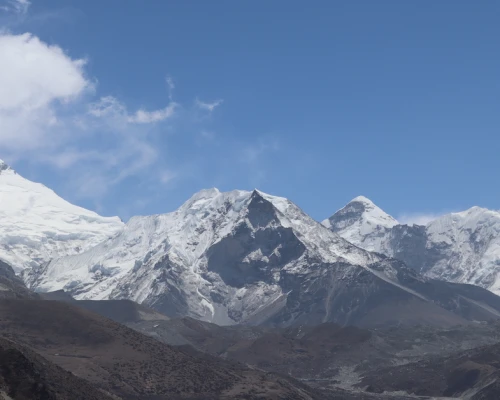Island Peak Climbing from Chhukung is a popular excursion for trekkers and climbers in the Everest Region. It is located in the center of the Chhukung valley, almost like an island. Because the west face is glaciated, climbing the summit requires a lot of work, but it's well worth it because the views from the top are spectacular. In addition, the stunning vistas of Everest, Makalu, Lhotse, and other peaks add to the thrill of the climb.
Island Peak Climbing expedition starting and ending in Chukhung. Our Island Peak Climbing Trip departs from Chhukung with dependability, and the group size is at least one. Therefore, you may join the Island Peak Climbing expedition from Chhukung, which entails trekking to Jiri, Phaplu, and Lukla. Different routes, such as Renjo La pass 5338 m, Chola Pass 5420 m, Kala Pattar 5545 m, and Khongma La gives 5535 m, can be used to acclimatize for island peak journeys.
Our team and partners will greet you in Chhukung and provide a summary of the Island Peak climbing expedition. After ascending Island Peak, our guide will drop you off at Chhukung, where you may then get ready for the following trek.
A short trek from Chhuking (4750m) leads to a little town where we relax for the day and prepare for the ascent. We continue to Island Peak Base Camp the next day, which is a tough climb followed by a pleasant stroll across the river valley. Finally, after a strenuous climb, we arrive at High Camp at 5600 meters, where we relax inside the tent and prepare for the next day's early morning ascent.
We climb to the peak through rock formations and glacier zones, using rope for assistance in certain parts. Finally, we descend to Chhukung, where we rest after the long trek and take the magnificent view from the summit. As a precaution against severe weather or physical illnesses, the trip has been extended by one day.
Island peak climbing is one of the most significant possibilities for trekkers doing the EBC, Gokyo, and 3-pass treks in the Everest region. A three-day package planned by Chhukung is one of the best options. If you want to join a group climbing the island peak, we can help you realize your objective of summiting the Island (Imja peak) and leaving your mark on the 6,173-meter mountain. Island Peak is one of the most adventurous climbing peaks and the ideal voyage for any mountaineering enthusiast trekking to Everest base camp. We provide Island Mountain climbing so that you may have a glimpse of the highest peak as well as another beautiful landscape. You have the option to fulfill a dream by possibly witnessing the magnificent Himalayan panorama from the highest point in the globe during this thrilling stroll through the Everest region.
Climbing Island Mountain is a fantastic chance for those aged 18 to 75 to climb a 6,173-meter-high adventure peak. After high camp and the crampon-wearing portions, the tricky section is a mixed rock and ice wall with a 45-degree slope leading to the narrow ridge. But, on the other hand, Island Peak is unquestionably a fitting reward for your efforts. In truth, climbing Island Peak is not as physically demanding as climbing Ama Dablam.
After completing any Khumbu area trip, the Island Peak from Chhukung is joined. Then, acclimatize through Jiri, Phaplu, Lukla, or any other corner of the Everest area via several passes, such as Renjo La (5,338m), Chola Pass (5420m), Kala Patthar (5,545m), and Kongma La (5,535m). Aside from the Island Peak climbing expedition, we also see unspoiled Sherpa communities and ever-so-serene monasteries with heavy memories of previous treks.
If you have a few additional days on your Everest region trip, you may join us on a climb of Island Peak, one of the most iconic hiking peaks in the region. During the climbing season, we set up a seasonal tent camp at base camp. As a result, any trekker can arrive at base camp at any moment. We have finalized the dates for the group joining the trip to climb the island peak from Chukung so that you can make your plans ahead of time. In addition, we can tailor the climbing component so that you arrive at base camp on your schedule.
Every novice and experienced climber who has been craving the thrill of adventure and want to go on adventure climbing excursions outside of merely hiking on Everest may now realize their dream by going on an Island Peak climbing trip. The most well-liked hiking mountain in Nepal is Island Peak. A heavily glaciated west face rising from the Lhotse Glacier makes the summit fascinating and beautiful. The hill itself is a continuation of Lhotse Shar's South Ridge that is divided from it by a minor gap.
Short Details of the Adventure Island Peak Climbing
- Island peak's base camp to summit and return to base camp is the most popular climbing segment of the island mountain.
- You can arrive at Island Peak base camp whenever you choose.
- With a very experienced climbing guide who has climbed it more than 200 times, there is an exceptional summit success rate.
- Travel with one of Nepal's top ten climbing companies.
- Base camp has a safety net in the form of an extra oxygen cylinder and medical supplies.
- At base camp will find all your personal and group climbing equipment.
- Imjatse base camp, climbing training
- While camping, all meals are included, including tea, coffee, and drinking water.
- The solar-powered tented camp base camp is environmentally friendly.
It is a relatively safe mountain to climb (the island peak rises to 6,189 meters), and mountaineers may easily reach the summit. Each year, the number of successful meetings at the island's peak grows. As a result, Islands Peak has a meager fatality rate compared to other climbing peaks, which they rarely notice since they are so cautious.






